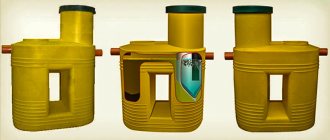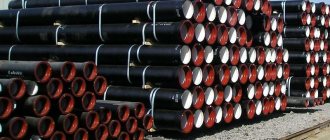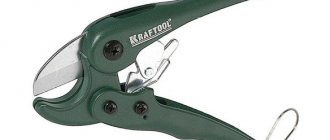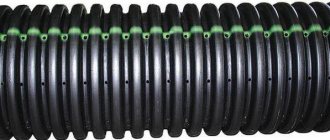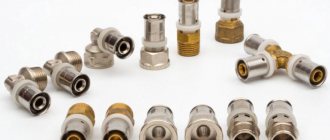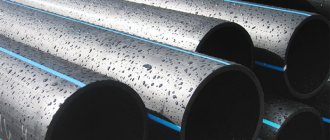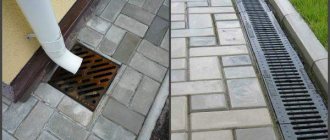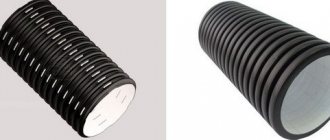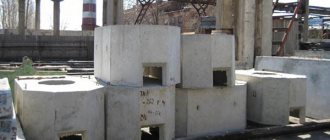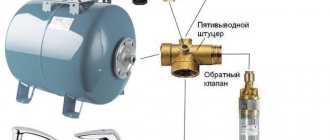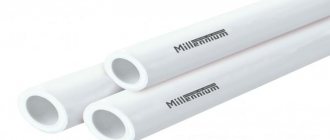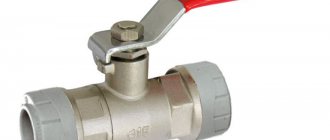Application area
The abbreviation PND stands for simply. This term refers to low-density polyethylene, a material that is not afraid of corrosion and is an excellent alternative to metal products. Unlike polypropylene, it is more elastic, less fragile and can withstand even severe frosts down to -50°C. The operating range of negative temperatures is -20°C, while polypropylene can only be used at -5°C. But even this temperature is already critical for him.
HDPE products are chemically resistant and do not react with the environment, therefore they are widely used for the installation of cold water supply pipelines, including when laying them in the ground. Indeed, unlike other plastics, HDPE has increased tensile strength and is able to change geometry without losing its tightness.
The range of HDPE pipes is quite large
The taste and composition of water passing through them is completely preserved. They are ideal for gas communications and sewer systems. Due to their increased resistance to low temperatures, HDPE pipes are also indispensable for laying external cold water supply systems.
High-density polyethylene is also used in land reclamation. It is also used as drainage to remove groundwater. Another advantage of low-density polyethylene is its price. This polymer costs much less than polypropylene.
Advice! It is not recommended to use this type of plastic for open installation outdoors due to its poor UV resistance. Therefore, according to GOST, it is allowed to store it in the light for no more than 2 months.
Products made from low-density polyethylene tolerate elevated temperatures less well - they can be used in operating mode up to +40°C. The melting point of this plastic is 103°C. Therefore, for laying hot water pipelines and heating systems, PEX (cross-linked polyethylene with cross-linked molecules) and metal-plastic polypropylene are used - pipes with a thin reinforced layer of fiberglass.
Metal-plastic refers to products made from plastic and fiberglass
Types of HDPE products
HDPE pipes are classified into two types - pressure and non-pressure. The differences between them lie in the level of maximum pressure that the plastic pipeline can withstand. The scope of application of HDPE pressure pipes is water supply (hot and cold), heating systems and sewerage communications; pressure pipes can also be used for gas transportation.
Gravity - designed for technical needs: they are used as casing when constructing water wells, for installing drainage systems and insulating high-voltage cables. According to technical standards, the use of these HDPE pipes when laying non-pressure sewerage is allowed.
For the manufacture of HDPE pipes, several modifications of polyethylene are used - PE63, PE80 and PE100 . Non-pressure pipes are made of PE63, pressure pipes are made of PE80 and 100. The difference between the modifications lies in the number of connected ethylene molecules in the crystalline network of the material; the numerical index in this case indicates the percentage of connections from the total number of molecules. The higher it is, the stronger and more resistant to deformation the product is, but at the same time less elastic.
HDPE products intended for use in the water supply sector are indicated by a blue stripe, products for gas pipelines - by a yellow stripe. Pipes for technical use and sewer systems are not color coded.
Manufacturing technology
Polyethylene pipes are produced by the extrusion method, the essence of which is to force the polymer melt through a nozzle of a certain shape. The production technology of HDPE products is implemented in the following sequence:
HDPE pipes for water supply
- The raw material (ethylene granules) is fed into an extrusion hopper, where ethylene melts under the influence of elevated temperature, after which chemical additives are added to the melt to provide the final material with the required performance properties.
- A certain pressure is maintained in the bunker, under the influence of which the melt is compacted, which leads to the connection of individual ethylene molecules into a continuous crystalline network.
- The melt is passed through an extrusion head (the design is equipped with cooling elements), during which the material takes the shape of the future pipe.
- The workpiece is rolled on a sizing mill, where the segment receives the final diameter, and is transferred to a water cooling tank.
- The product is marked and goes to the cutting line, where it is cut into sections of the required length.
There is also a category of LDPE pipes (LDPE - high-density polyethylene). For their production, similar raw materials are used; the differences lie in the production technology itself - the level of pressure maintained in the bunker at the stage of melting ethylene granules.
LDPE pipes differ significantly in terms of performance characteristics. LDPE is a soft, elastic material, while low-density polyethylene is hard and has minimal plasticity (LDPE pipes are sold in coils 100 m long, while HDPE products with a diameter of 50 mm or more do not bend and are sold in lengths of 2-8 meters).
The scope of application of LDPE pipes is internal water supply and land reclamation systems. LDPE pipes are not used for the installation of heating pipelines and hot water supply, since their temperature maximum is +40 degrees.
Installation of HDPE pipes by welding (video)
Production Features
Almost half of polyethylene products are produced by polymerization at low pressure. For this, two main methods are used - in suspension (suspension, mixture of substances) and gas-phase. The third method, solution polymerization, is used less frequently.
The raw material for HDPE is ethylene, isolated from oil and gas, purified, and containing a small amount of oxygen. To obtain a suspension, ethylene is mixed with catalysts titanium chloride and aluminum radicals, heated to 120-150°C at a reduced pressure of 0.1-2 mPa. To regulate fluidity, special additives are also introduced into the composition.
The reactor in which the polymerization process occurs is a vertically installed apparatus equipped with a cooling “water jacket.” The apparatus is further cooled by blowing off ethylene that has not had time to react with the catalysts. After cooling, it returns back to the reactor.
In the gas-phase method, chromium compounds serve as catalysts. In this case, the composition is heated to 90-115°C at a pressure of 2.1 MPa. At the output, the mass of low-density polyethylene is about 97% of the total amount. The resulting plastic is separated from the solution by removing catalyst compounds, solvents and gases. This process takes place in a continuous centrifuge. Further purification is carried out in a separator and granulator. The last stage is steaming the granules and drying them in hot nitrogen.
Polymerization of plastic
What is HDPE
Pipes made from ethylene at low pressure - that’s what HDPE is, if explained in simple terms. They are widely used in repair and construction work, displacing fragile and unreliable metal pipes.
The use of low-density polyethylene solves problems such as reliability and durability of communications, while reducing the cost of installation and maintenance of pipelines.
Low-pressure pipes are produced by using a continuous extrusion method - melting a polymer and forcing a viscous material through a forming hole.
At the initial stage of production, substances are added to the material that are responsible for the technical characteristics and color of the finished product.
In production, high-density polyethylene is used, obtained at low operating temperatures - from +120 to +150 degrees, and low pressure - from 0.1 to 2 MPa.
The manufacturing process is simple, productive and more economical than the production of metal analogues.
Water pipelines made of polyethylene are several times cheaper than cast iron and concrete, while construction time is reduced, they do not need insulation, and they have a long service life.
In international standards, the abbreviation HDPE is denoted by the letters HDPE.
Pipes are manufactured in accordance with quality standards, which means that they are characterized by high density, increased strength, durability and excellent resistance to various chemical compounds. The composition allows them to be used for transporting drinking water.
Range
Based on their purpose, HDPE pipes are divided into several groups. To make it easier to distinguish them, each type is painted in a specific color:
- tap water: intended for supplying drinking water, painted blue; black products with longitudinal blue veins can withstand even freezing without loss of integrity and do not fade under the sun;
- casing for wells: high-strength blue or black;
- gas: yellow or black with yellow stripes;
- irrigation: pure black;
- sewer: their color depends on operating conditions; gray and white are intended for indoor use; orange and brown (harder and more durable) - for laying highways outdoors; black – for sewage;
- drainage: corrugated, flexible and rigid, able to withstand the weight of the soil, painted blue or green;
- technical: color depends on the type of working fluid.
Advice! You should pay attention not only to the color, but also to the markings. After all, according to GOST, coloring does not necessarily indicate the purpose of pipelines. Therefore, unscrupulous manufacturers may well apply blue stripes to products intended only for technical needs.
The color of the products depends on their purpose
HDPE release form
The form of polyethylene pipes depends on the diameter - they are produced in the form of segments and coils. Typically, pipes with a diameter of 110 mm or less are supplied in coils, the length of which can be up to several hundred meters. Long pipes are convenient for underground installation, as well as for organizing irrigation systems and laying cables.
The length of pipes in the form of straight sections ranges from 3 to 24 meters; they are convenient to use when laying networks in homes.
To make it convenient to recognize pipes by type of application, they are marked with special markings - color markings, in accordance with international standards. Deep blue HDPE or a dark pipe with a thin blue stripe along its entire length is intended for tap water. Completely yellow, as well as pipes with a yellow longitudinal stripe on a dark background, means its use in gas pipeline systems.
A gray or black pipe without any additional color elements is made for sewerage or technical needs.
Polyethylene pipes are available in several types. More durable ones are used for pressure lines with operating pressures up to 5 or 20 atm. There are varieties designed for operation in conditions close to vacuum. Double-walled pipes, which have an outer corrugated coating and an inner smooth-walled pipeline, are used in difficult areas with increased load, where ground movement is possible. Reinforced HDPE has increased rigidity.
Specifications. Marking
According to GOST, such products are designated not by the letters HDPE, but by PE (polyethylene). They can be marked either by embossing or using a printer with paints. In this case, the following must be indicated:
- name of GOST according to which the product was manufactured;
- manufacturing company;
- type of material (PE);
- strength (density): its indicator is the numbers following the first letters; for example, the designation PE100 is used for products of greater strength; PE80 pipes are not as durable and can withstand less load;
- outer and inner diameter;
- wall thickness;
- nominal (working) pressure at which the product can be operated;
- maximum pressure;
- production date and batch number.
In addition to the above parameters, the markings indicate the letters SDR. This is the strength of the walls. The numbers following the letters show how the outer diameter relates to the wall thickness, that is, how capable they will be of resisting pressure changes. The smaller the numbers following the SDR, the stronger the product. But the weight of such a HDPE pipe will be significant.
The S marking and the numbers following it are also considered an indicator of strength. However, this indicator is more laboratory, and users rarely pay attention to it.
PE pipe marking
Standard sizes and markings
The diameter of HDPE pipes depends on their functional purpose:
- for water supply they have a diameter from 16 to 120 mm;
- for sewerage – from 40 to 200 mm;
- for water wells – from 125 to 200 mm
Products intended for different areas of use differ in terms of installation features. HDPE pipes for wells are connected using threads, sewer pipes are connected using sockets or soldering, and shaped fittings are used for joining water pipes.
HDPE pipes have a unified marking of type PE80 SDR13 40*1.2 Drinking GOST No. xxx. This designation has the following meaning :
- PE80 – modification of polyethylene used for manufacturing;
- SDR13 – ratio of wall thickness and diameter;
- 40*1.2 – diameter*wall thickness;
- drinking - area of use;
- GOST No.xxx is the technical standard according to which the product is manufactured.
SDR is the ratio of thickness to diameter, on which the ring strength directly depends. This parameter is extremely important to take into account when choosing pipes for laying external sewerage and water supply lines, which during operation will experience pressure from the overlying soil layers.
Here is a description of the SDR parameter for polyethylene pipes of the most popular sizes:
- HDPE 25 – available with a wall thickness of 2 mm (SDR 17.6, weight per linear meter - 152 g) and 2.3 mm (SDR 11, weight - 174 g);
- HDPE 32 – wall thickness 2 mm (SDR 17.6, weight – 199 g) or 3 mm (SDR – 11, weight – 283 g);
- HDPE 63 – wall thickness from 2 to 5.8 mm, SDR from 11 to 43, weight 401-1071 g;
- HDPE 110 – wall thickness from 3 to 10 mm, SDR from 11 to 40, weight 0.95-3.2 kg;
- HDPE 160 – wall thickness from 3.9 to 14.6 mm, SDR from 11 to 40, weight 1.97-6.7 kg.
SDR plastic pipes of identical diameter
A separate category includes corrugated HDPE products used as intermediate hoses (insulating sheath) when laying electrical cables. Corrugated pipe is available in a diameter range of 16-63 mm; it has increased flexibility and strength due to the presence of stiffeners.
Corrugated pipe is used when it is necessary to install hidden wiring, in which the cables are concreted inside walls and interfloor ceilings.
Standard sizes
The key parameters for this type of product according to GOST 18599 are the diameter and wall thickness (see size table). The minimum diameter of pipes with a density of PE33 is only 10 mm. The maximum parameter for products of similar strength is 160 mm. Wall thickness 2-12 mm. They are designed for systems with a pressure of only 3.2 MPa.
For products with increased strength PE100, the minimum and maximum diameters are already 32 and 1000 mm, respectively. The wall thickness for them will be 1-59 mm. Through such pipes, liquid with a pressure of up to 10 MPa can be passed.
Table 1 - HDPE pipes, main dimensions with wall strength PE-80 and PE-100
Advantages and disadvantages of HDPE
HDPE pipes (HDPE is also acceptable) have many advantages:
- service life up to 50 years;
- light weight;
- frost resistance, low level of thermal conductivity;
- are not subject to rust;
- resistant to aggressive liquids;
- can be bent without loss of tightness;
- wide choice of diameters;
- have convenient markings;
- easy and quick to install;
- there are no seams, scale and silty deposits do not form on the smooth inner surface;
- the plastic from which they are made is completely environmentally friendly;
- low cost of HDPE materials.
Low pressure pipes also have disadvantages:
- do not tolerate too high temperatures;
- not UV resistant;
- the maximum permissible pressure is 2.0 MPa, which limits their use for industrial purposes;
- lower mechanical strength compared to metal or concrete;
- During installation it is necessary to use special connecting elements.
High-density polyethylene (HDPE) has largely similar properties, but it has a low density and, as a rule, is not used for water supply networks.
average cost
When purchasing products, you should also pay attention to the price tag. If the cost of pipes is below the market average, their quality is unlikely to be up to par. After all, no enterprise will operate at a loss.
The service life of plastic products largely depends on the composition of the raw materials and is on average 50 years. When using waste ("recycled") - bottles, polyethylene boxes and even disposable syringes - even a properly installed water supply or sewer system will fail within a year and a half. Tap water passing through such pipes will have a strong chemical smell. As a rule, such products do not have any markings and are made of plastic that is not uniform in color.
Table 2 - Average price of HDPE pipes of different diameters
| Purpose | Outer diameter, mm | Wall thickness, mm | Unit change | Cost, rub.) |
| Technical | 16 | 2,0 | m | 10 |
| Pressure drinking | 20 | 2,0 | m | 23 |
| Pressure drinking | 25 | 2,0 | m | 25 |
| Pressure drinking | 32 | 2,4 | m | 47 |
| Gas | 32 | 3,0 | m | 58 |
| Pressure drinking | 50 | 3,0 | m | 81 |
| Sewer (for internal sewerage) | 50 | 1,8 | m | 74 |
| Water pumps | 63 | 3,8 | m | 129 |
| Technical | 110 | 6,3 | m | 180 |
| Water pumps | 110 | 6,6 | m | 349 |
| Sewer (for internal sewerage) | 110 | 2,7 | m | 102 |
| External sewer | 125 | 9,2 | m | 175 |
| Gas | 125 | 9,2 | m | 220 |
Application of low density polyethylene
Polyethylene granules are used in the manufacture of:
- films with a smooth and air-bubble surface;
- plastic pipes and fittings for general purpose pipelines;
- insulation of cables and wires;
- HDPE bags and packaging tapes;
- sheet materials and other products made using an extruder;
- using the blowing method, they create reservoirs and containers for storing liquids and household chemicals;
- they produce souvenirs and furniture fittings under pressure from a polymer melt; plastic toys are widespread;
- polymer kitchen utensils, household utensils and home accessories;
- Foamed polyethylene, more often called polyethylene foam, is often used as thermal insulation.
The products are distinguished by an optimal price-quality-light weight-durability ratio combined with high strength indicators. The higher consumer properties of HDPE, compared to natural and composite materials, have become a competitive advantage of the polymer.
Leading manufacturers
In Russia, more than 100 enterprises are engaged in the production of PE pipes. But the main volume of products produced falls on 6 main ones: they account for 20% of the total volume of similar products produced in our country; its range is considerable - the company offers pipes of different diameters (10-1200 mm) and purposes;
- "Polyplastic": owns 10 factories located not only in Russia, but also in the CIS; the largest of them is Irkutsk.
Poliplastik LLC is one of the six largest enterprises in the Russian Federation producing PE products
How to choose the right HDPE pipe
In order for the choice to meet your goals, you need to decide in which area the products will be used, and also consider operating parameters: depth in the ground, temperature conditions, aggressiveness of the environment.
For example, if you plan to install a water supply system, only HDPE pipes with a blue stripe are suitable. The fact is that they are made from virgin polyethylene and are completely harmless to both animals and humans. The use of black technical pipes not marked with colored stripes for these purposes is strictly prohibited, since they are made from recycled materials, which means that harmful substances can be released into the water.
When sewerage is carried out, socket elements are used, drainage - perforated structures. In this case, it is worth considering the load on the product. It depends on the depth or thickness of the concrete screed above them. If the load level is high (for example, when the layer of earth above the communication exceeds one and a half meters, there is a massive screed or rocky soil), it is advisable to use two-layer corrugated pipes.
Smooth structures are suitable for casing structures, electrical cables, information communications, and pipelines.
It is recommended to use pipes of a color that corresponds to the intended purpose in any work. Then, in case of repair, it will be easy to determine the necessary communication, and when buried in the ground, the bright color of the structure will be easy to detect.
Laying HDPE pipes in trenches
Installation of pipelines in the ground involves the formation of open excavations, the size of which is determined by hydrogeological conditions and the level of soil freezing. The last parameter is individual for different regions of Russia. For example, in Volgograd it is 120 cm, and in Moscow – 140 cm.
As for the width, the trench along the bottom should correspond to the diameter of the pipes:
- for D 120…140 cm optimally D+50 cm;
- from 70 cm – 1.5D;
- up to 70 cm – D+30 cm.
Polyethylene pipes are a suitable material for underground pipeline networks and highways. They are inexpensive, last a long time, and are easy to transport and stack. The main thing when choosing is to take into account the type, marking and the presence of a color stripe.
Important! Elements with compression fittings cannot be placed in the trench: solid segments that do not have additional joints should be placed in the ground. The exception is sections connected by welding.
Cost of HDPE pipes
Due to the low costs of raw materials, such products are widely in demand in all areas of municipal economic activity. The combination of an affordable price and progressive properties explains their active use in the role of sewer, gas and water supply elements. They are also used for wiring utility networks indoors and laying cable systems underground.
The most expensive are pipes made of PE-100 (sdr 26, 21, 17.6, 17, 13.6 and 11). They withstand high pressure loads, are resistant to mechanical stress and are recommended for gas pipelines. The maximum level of durability is a thousand hours of continuous operation, even under internal stress. That is, at the moment the liquid freezes, their walls still remain intact.
Pipes made from PE-80 are slightly lower in cost, since they are made from medium-density polyethylene. It is less resistant to pressure loads and is not suitable for areas with moving soil.
Important! The price of polyethylene pipes is very favorable, because the raw materials are cheap, so the products made from them are inexpensive. However, this does not harm the quality.
Self-installation of water supply
Since installing a water supply system from HDPE pipes does not require expensive equipment or special professional skills, it can be done with your own hands. The first step is to draw up a diagram, where you must indicate the location of water intake and the location of the source. Using the finished scheme, the need for material is calculated and everything necessary for work is prepared:
- pipe set;
- fitting connections;
- taps and other connecting elements;
- adapters of the required diameter;
- hacksaw for metal;
- end cone knife;
- shovel.
Detachable connection of polyethylene pipes
The installation technology itself is simple, but in order for the water supply to last the period allotted by the pipe manufacturer, certain rules must be followed during installation:
- At the bottom of the trench dug in the ground, it is necessary to place a 100 mm cushion of fine gravel or sand, and then compact it. Otherwise, there is a risk of damage from objects that may fall under it.
- When laying water pipes, their connections should be slightly recessed into the cushion.
- If the pipe needs to be bent a little, then in the summer the sun is enough, and the rest of the time heating is carried out using a hairdryer or using boiling water.
Tip: If you have to heat the pipe, do it carefully.
If the temperature is insufficient, it will break, and if overheated, it will ignite, resulting in reduced strength. When carrying out installation yourself, you should know that there are 2 types of PE pipe connections: one-piece and detachable. For the first one, you need to have special welding equipment. Most often, pipes are butt welded and electric couplings are used. This method is mainly used for large diameter pipelines.
An example of a permanent pipe connection
The second type of connection is made using flange or socket fittings, equipped with elastic seals. You don't need a special tool for this. The method is ideal when the pipeline operates without pressure and small diameter pipes are used.
Thus, HDPE pipes are the most suitable, inexpensive material for laying a water supply system.
